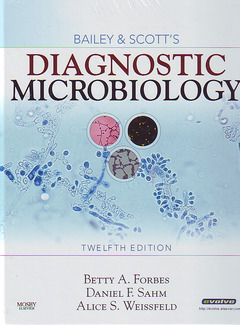Description
Bailey & Scott's diagnostic microbiology (12th Ed.)
Authors: FORBES Betty A., SAHM Daniel F., WEISSFELD Alice S.
Language: English
Subject for Bailey & Scott's diagnostic microbiology:
Approximative price 104.99 €
Subject to availability at the publisher.
Add to cart
Publication date: 01-2007
1056 p. · 22x28 cm · Paperback
1056 p. · 22x28 cm · Paperback
Description
/li>Contents
/li>
The new 12th edition of Bailey & Scott's Diagnostic Microbiology solidifies its reputation as the classic text in the field of microbiology. This new edition features the same comprehensive, authoritative content — and adds new and updated material throughout. The team of authors includes three well-respected clinical microbiologists, all of whom have experience both in the classroom and the clinical laboratory.
Part I: Basic Medical Microbiology1. Microbial Taxonomy 2. Bacterial Genetics, Metabolism, and Structure3. Host-Microorganism Interactions Part II: General Principles in Clinical MicrobiologySection I: Safety & Specimen Management4. Laboratory Safety5. Specimen ManagementSection II: Approaches to Diagnosis of Infectious Diseases6. Role of Microscopy7. Traditional Cultivation and Identification 8. Nucleic Acid-Based Analytic Methods For Microbial Identification And Characterization9. Immunochemical Methods Used for Organism Detection10. Serologic Diagnosis of Infectious DiseasesSection III: Evaluation of Antimicrobial Activity11. Principles of Antimicrobial Action & Resistance12. Laboratory Methods and Strategies for Antimicrobial Susceptibility TestingPart III: BacteriologySection 1: Principles of Identification13. Overview of Bacterial Identification Methods and Strategies14. General Considerations and Applications of Information Provided in Bacterial Sections of Part III NEW!15. Bacterial Identification Flow Charts and Schemes: A Guide to Part III NEW!Section 2: Catalase-Positive, Gram-Positive Cocci16. Staphylococcus, Micrococcus, and Similar OrganismsSection 3: Catalase-Negative, Gram-Positive Cocci17. Streptococcus, Enterococcus, and Similar OrganismsSection 4: Non-Branching, Catalase-Positive, Gram-Positive Bacilli18. Bacillus and Similar Organisms19. Listeria, Corynebacterium, and Similar OrganismsSection 5: Non-Branching, Catalase-Negative, Gram-Positive Bacilli20. Erysipelothirix, Lactobacillus, and Similar OrganismsSection 6: Branching or Partially Acid-Fast, Gram-Positive Bacilli21. Nocardia, Streptomyces, Rhodococcus, Oerskovia, and Similar OrganismsSection 7: Gram-Negative Bacilli and Coccobacilli (MacConkey-Positive, Oxidase-Negative)22. Enterobacteriaceae23. Acinetobacter, Stenotrophomonas, and Other OrganismsSection 8: Gram-Negative Bacilli and Coccobacilli (MacConkey-Positive, Oxidase-Positive)24. Pseudomonas, Burkholderia, and Similar Organisms25. Achromobacter, Rhizobium, Ochrobactrum, and Similar Organisms26. Chryseobacterium, Sphingobacterium, and Similar Organisms27. Alcaligenes, Bordetella (Nonpertussis), Comamonas, and Similar Organisms28. Vibrio, Aeromonas, Plesiomonas shigelloides, and Chromobacterium violaceumSection 9: Gram-Negative Bacilli and Coccobacilli (MacConkey-Negative, Oxidase-Positive)29. Sphingomonas paucimobilis and Similar Organisms30. Moraxella31. Eikenella corrodens and Similar Organisms32. Pasteurella and Similar Organisms33. Actinobacillus, Kingella, Cardiobacterium, Capnocytophaga, and Similar OrganismsSection 10: Gram-Negative Bacilli and Coccobacilli (MacConkey-Negative, Oxidase-Variable)34. HaemophilusSection 11: Gram-Negative Bacilli that are Optimally Recovered on Special Media35. Bartonella and Afipia36. Campylobacter, Arcobacter, and Helicobacter37. Legionella38. Brucella39. Bordetella pertussis and Bordetella parapertussis40. Francisella41. Streptobacillus moniliformis and Spirillum minusSection 12: Gram-Negative Cocci42. Neisseria and Moraxella catarrhalisSection 13: Anaerobic Bacteriology43. Overview and General Considerations44. Laboratory ConsiderationsSection 14: Mycobacteria and Other Bacteria with Unusual Growth Requirements45. Mycobacteria46. Obligate Intracellular and Nonculturable Bacterial Agents47. Cell Wall-Deficient Bacteria: Mycoplasma and Ureaplasma48. The SpirochetesPart IV: Parasitology49. Laboratory Methods for Diagnosis of Parasitic InfectionsPart V: Mycology50. Basic MycologyPart VI: Virology51. Laboratory Methods in Basic VirologyPart VII: Diagnosis by Organ System52. Bloodstream Infections53. Infections of the Lower Respiratory Tract54. Upper Re
© 2024 LAVOISIER S.A.S.



